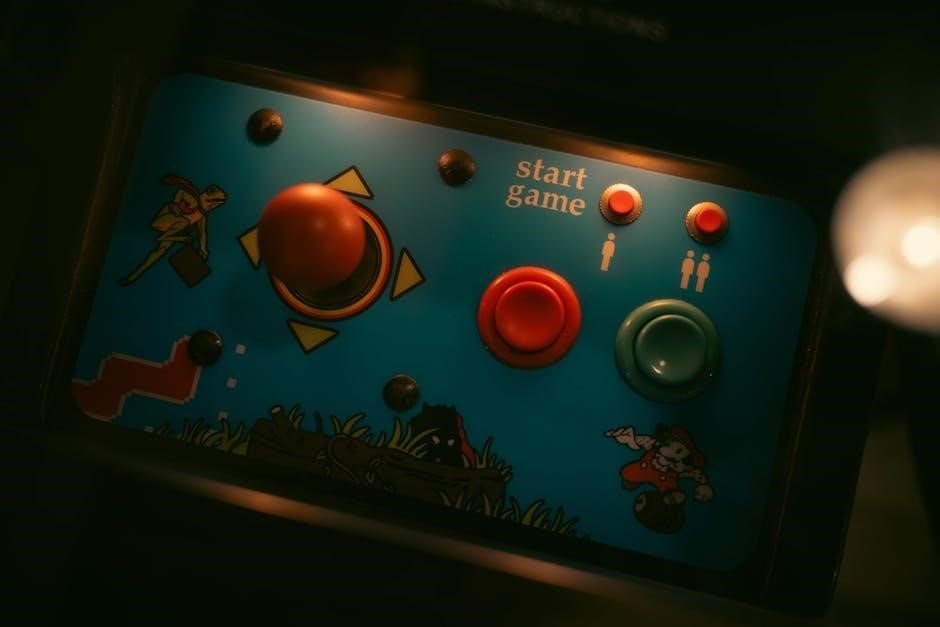
video game manuals
Video game manuals are essential guides providing gameplay instructions‚ lore‚ and artwork. Once physical booklets‚ they’ve evolved into digital formats‚ adapting to modern gaming trends while preserving their informative charm.
1.1 Historical Overview of Video Game Manuals
Video game manuals originated in the early days of gaming‚ serving as essential guides for understanding gameplay mechanics and controls. In the 1980s and 1990s‚ these manuals were often detailed booklets filled with lore‚ artwork‚ and tips. They provided a physical connection to the game world‚ offering insights that couldn’t be conveyed through the game itself. Early manuals were particularly vital for complex titles like RPGs‚ where they explained intricate systems and storylines. Over time‚ they evolved from simple instruction pamphlets to immersive storytelling tools‚ becoming a cherished part of gaming culture and education.
1.2 Importance of Manuals in Gaming Culture
Video game manuals were more than just instruction guides; they bridged the gap between physical and digital gaming‚ making complex systems approachable. Filled with lore‚ artwork‚ and tips‚ they immersed players in the game world before the first button was pressed. These manuals became cherished collectibles‚ offering a tangible connection to the game’s universe. They also served as educational tools‚ especially for RPGs and strategy games‚ explaining mechanics and storylines in depth. Their detailed passion and creativity inspired players‚ fostering a deeper appreciation for the game’s design and narrative. Today‚ manuals remain a nostalgic symbol of gaming’s evolution and cultural heritage.

The Evolution of Video Game Manuals
Video game manuals evolved from simple instruction booklets to detailed guides‚ peaking in the 1980s-1990s with rich lore and artwork‚ before transitioning to digital formats and in-game tutorials.
2.1 Early Years: From Simple Instructions to Detailed Guides
In the early days of gaming‚ manuals were minimal‚ often containing basic controls and objectives. As games grew more complex‚ especially with RPGs and strategy titles‚ manuals expanded to include detailed mechanics‚ lore‚ and artwork. These guides became essential for understanding intricate systems‚ offering tips‚ and providing context that the games themselves couldn’t convey. Manuals like those for Baldur’s Gate and The Elder Scrolls II: Daggerfall were exhaustive‚ detailing spells‚ enemies‚ and gameplay strategies. They also served as storytelling tools‚ immersing players in the game’s world before they even started playing‚ making them a cherished part of the gaming experience.
2.2 The Golden Age of Video Game Manuals (1980s-1990s)

The 1980s and 1990s marked the golden age of video game manuals‚ where they evolved from simple instruction booklets to detailed‚ creative guides. Manuals for games like Fallout and Sim City 2000 included concept art‚ lore‚ and even fictional narratives‚ enhancing immersion. They often served as storytelling devices‚ with some manuals written from in-game perspectives or designed to resemble in-universe items. These manuals were meticulously crafted‚ offering exhaustive details on gameplay mechanics‚ strategies‚ and world-building. Their depth and creativity made them cherished collectibles‚ bridging the gap between physical and digital gaming and leaving a lasting impact on gaming culture.
2.3 Role of Manuals in RPGs and Complex Games
Manuals played a crucial role in RPGs and complex games‚ offering detailed explanations of mechanics‚ spells‚ enemies‚ and lore. Games like Baldur’s Gate and The Elder Scrolls II: Daggerfall featured extensive manuals with sections for notes‚ helping players track intricate details. These guides often included concept art and narratives‚ enriching the gaming experience. They served as lore repositories‚ providing backstory and setting context that enhanced immersion. For complex titles‚ manuals were indispensable‚ acting as both instructional tools and storytelling devices that deepened players’ understanding and engagement with the game world.
Decline of Physical Video Game Manuals
Physical video game manuals declined as digital formats and in-game tutorials became prevalent. Smaller packaging and rising costs made physical manuals less practical for publishers.
3.1 Shift to Digital and In-Game Tutorials
The shift to digital and in-game tutorials marked a significant change in how players interact with game information. Modern games now rely on interactive tutorials‚ cutscenes‚ and dynamic guidance systems to teach mechanics and story elements. This approach eliminates the need for physical manuals‚ as instructions are seamlessly integrated into the gameplay experience. Digital formats also allow for real-time updates‚ ensuring players always have the most current information. While physical manuals are no longer the norm‚ their legacy lives on in optional digital PDFs and collector’s editions‚ catering to nostalgia and dedicated enthusiasts.
3.2 Impact of Smaller Packaging on Manual Inclusion
The trend toward smaller packaging significantly reduced the inclusion of physical manuals. As games became more mainstream‚ publishers opted for compact designs to lower production costs and simplify distribution. This shift forced manuals to shrink from detailed booklets to brief pamphlets‚ often omitting creative elements like artwork and lore. While some niche titles and collector’s editions still include physical manuals‚ they are no longer standard. The rise of digital distribution further accelerated this decline‚ making physical manuals a rarity in modern gaming.
3.4 The Rise of Digital Distribution Platforms
The rise of digital distribution platforms like Steam‚ GOG‚ and the Epic Games Store has revolutionized how video game manuals are accessed. Digital manuals are now standard‚ often included as PDF files with game downloads. This shift eliminates the need for physical storage‚ making manuals more accessible and environmentally friendly. Digital distribution also enables easy updates‚ ensuring manuals stay current with game patches. While some players miss physical manuals‚ digital versions offer convenience and compatibility across devices. This trend aligns with the broader shift toward digital gaming‚ reducing reliance on physical media and streamlining the gaming experience for modern players.

Modern Video Game Manuals
Modern video game manuals have transitioned to digital formats‚ often as PDFs‚ with some featuring interactive guides. Collectors’ editions still include physical manuals‚ blending nostalgia with exclusive artwork and lore.
4.1 Digital Manuals and PDF Formats
Digital manuals have become the norm‚ replacing physical booklets with downloadable PDFs. These files are often included with game downloads or available online‚ offering easy access to controls‚ lore‚ and tips. Platforms like Steam and GOG frequently provide digital manuals for retro and modern titles‚ preserving the tradition for nostalgic players. PDF formats allow for quick searches and easy navigation‚ enhancing usability. This shift supports environmental sustainability and caters to both modern and retro gaming communities‚ ensuring manuals remain relevant in the digital age while maintaining their informative and artistic charm.

4.2 In-Game Resources and Interactive Guides
Modern games often integrate in-game resources and interactive guides‚ replacing traditional manuals. These tools provide contextual tips‚ tutorials‚ and dynamic explanations‚ helping players learn mechanics as they play. Interactive guides‚ such as pop-up hints or mini-tutorials‚ enhance accessibility and immersion. Some games feature extensive in-game encyclopedias or glossaries‚ detailing lore‚ characters‚ and strategies. This approach streamlines the learning process‚ reducing the need for external manuals. In-game resources adapt to player progress‚ offering tailored advice and fostering a more engaging experience. They represent a natural evolution of instructional content‚ blending seamlessly with gameplay while maintaining the educational charm of classic manuals.
4.3 Collectors Editions and Special Releases
Collectors editions and special releases often include physical or digital manuals as a nod to gaming nostalgia. These manuals frequently feature exclusive artwork‚ lore‚ and detailed gameplay insights‚ enhancing the collector’s experience. Titles like Cyberpunk 2077 and Stardew Valley include such manuals‚ offering fans a tangible connection to the game’s world. Additionally‚ niche titles and retro re-releases‚ such as those on Steam or GOG‚ often bundle digital manuals with their downloads. These inclusions cater to both nostalgic players and new collectors‚ preserving the tradition of game manuals while adapting to modern distribution methods.

Video Game Manuals in Collectors Editions
Collectors editions often include physical or digital manuals‚ offering exclusive artwork‚ lore‚ and gameplay insights. These manuals cater to nostalgic and modern gamers‚ enhancing the collector’s experience.
5.1 Niche Titles and Retro Re-Releases
Niche titles and retro re-releases often include physical or digital manuals‚ catering to nostalgic gamers and collectors. Games like Rune Factory 4 Special and Sakuna: Of Rice and Ruin feature manuals‚ preserving tradition. Retro re-releases on platforms like Steam and GOG frequently bundle digital manuals‚ replicating the original experience. These manuals often include artwork‚ lore‚ and gameplay tips‚ enhancing the collector’s appeal. For enthusiasts‚ they serve as a bridge to gaming’s past‚ offering a tangible connection to classic titles. This practice ensures that even in the digital age‚ the charm of physical manuals endures for dedicated fans and retro gaming enthusiasts.
5.2 Artwork‚ Lore‚ and Bonus Content in Modern Manuals
Modern video game manuals often feature stunning artwork‚ lore‚ and bonus content‚ enhancing the gaming experience. Collectors’ editions include concept art‚ character designs‚ and detailed backstories‚ immersing players in the game’s universe. Digital manuals and PDF formats allow for high-resolution images and interactive elements‚ such as galleries or behind-the-scenes content. Some manuals even resemble in-game objects‚ like Fallout’s Vault Dwellers Survival Guide‚ complete with fictional notes and annotations. These additions not only preserve the game’s history but also offer fans a tangible connection to the world and its creation‚ making manuals a cherished part of gaming culture and collectibles.
The Role of Video Game Manuals in Preservation
Video game manuals serve as vital historical artifacts‚ preserving gameplay mechanics‚ lore‚ and artwork. Projects like The Manual Project and ReplacementDocs digitize and archive manuals‚ ensuring gaming history endures for future generations.
6.1 The Manual Project and Community Efforts
The Manual Project‚ initiated in 1999‚ aims to preserve video game history by scanning and archiving manuals. This community-driven effort ensures that gamers can access manuals online or download them as PDFs. By digitizing these documents‚ the project safeguards the legacy of classic and modern games‚ offering a valuable resource for collectors and enthusiasts. Community contributions are vital‚ with volunteers scanning and uploading manuals to create a comprehensive library. This collaborative approach highlights the importance of manual preservation‚ fostering nostalgia and educational insights into gaming’s evolution.
6.2 ReplacementDocs and Open Access to Game Manuals
ReplacementDocs is a vital resource for gamers‚ offering free access to video game manuals‚ guides‚ and walkthroughs. This platform hosts a wide range of documents‚ providing detailed strategies and tips for completing games. It supports both retro and modern titles‚ ensuring that players can access information for older games and niche releases; ReplacementDocs also fosters community involvement‚ allowing enthusiasts to contribute and preserve gaming history. By making these resources freely available‚ it bridges the gap between physical and digital gaming‚ offering a nostalgic and practical tool for gamers worldwide.
Video Game Manuals as a Storytelling Device
Video game manuals often served as storytelling tools‚ providing lore‚ backstory‚ and immersive details. They sometimes took the form of in-game objects‚ like Fallout’s Vault Dweller’s Guide.
7.1 Lore and Backstory in Manuals
Video game manuals often included rich lore and backstory‚ enhancing immersion by detailing characters‚ worlds‚ and plot elements. These narratives were sometimes presented as in-game objects‚ like Fallout’s Vault Dweller’s Survival Guide‚ which mimicked an in-universe handbook. Manuals for games like Age of Mythology and Civilization provided historical and mythological context‚ adding depth to gameplay. Such storytelling elements helped players connect with the game’s universe before even starting the adventure‚ making manuals a cherished part of gaming culture and a bridge to the digital experience.
7.2 Examples of Manuals as In-Game Objects
Some video game manuals were crafted to resemble in-game objects‚ deepening immersion. For instance‚ Fallout’s “Vault Dweller’s Survival Guide” is presented as an in-universe handbook‚ complete with notes from Vault 13’s Overseer. Similarly‚ manuals for titles like Baldur’s Gate and The Elder Scrolls II: Daggerfall included detailed lore and backstory‚ often written from the perspective of fictional characters. These creative designs blurred the line between the physical manual and the game world‚ enhancing the overall narrative experience and making the manual an integral part of the adventure.

Video Game Manuals and Educational Content
Video game manuals often provided historical‚ mythological‚ and cultural context‚ enriching gameplay with educational value. Titles like Age of Mythology and Civilization included detailed informative sections‚ enhancing player knowledge.
8.1 Historical and Mythological Context in Games

Video game manuals often provided rich historical and mythological context‚ enhancing gameplay with educational depth. Games like Age of Mythology detailed mythological figures‚ while Sid Meier’s Civilization explained historical eras and leaders. These manuals served as gateways to understanding the cultural and historical inspirations behind the games‚ offering players a deeper connection to the narratives. By including such content‚ manuals not only guided gameplay but also educated players about real-world history and mythology‚ making the gaming experience more immersive and intellectually engaging. This approach highlighted the potential of games as tools for learning and cultural appreciation.
8.2 Educational Approach in Strategy and Simulation Games
Strategy and simulation games often use manuals to deliver educational content‚ blending gameplay with learning. Titles like Sid Meier’s Civilization include detailed historical context‚ explaining eras‚ governments‚ and leaders. Sim City 2000 educates on urban planning‚ infrastructure‚ and economics‚ while also featuring poems and recommended readings. These manuals serve as comprehensive resources‚ teaching players about complex systems and real-world concepts. By integrating educational elements‚ they enhance the gaming experience‚ making players think critically and strategically. This approach not only entertains but also informs‚ demonstrating the potential of games as educational tools.
The Art and Design of Video Game Manuals
Video game manuals often feature concept art‚ illustrations‚ and unique layouts‚ enhancing the gaming experience with visual storytelling and immersive design that complements gameplay.
9.1 Concept Art and Illustrations in Manuals
Video game manuals often showcased concept art and illustrations‚ providing glimpses into the game’s visual development. These artworks‚ ranging from character designs to environmental sketches‚ enriched the gaming experience by offering a deeper connection to the game’s world. For example‚ manuals like Fallout’s Vault Dweller’s Survival Guide featured in-universe illustrations that immersed players in the game’s lore. Similarly‚ Age of Mythology’s manual included detailed mythological artwork‚ blending education with entertainment. These visuals not only enhanced the manual’s appeal but also served as a bridge between the physical and digital aspects of gaming‚ making the manuals a cherished part of the game’s identity.
9.2 Creative Design Elements and Unique Layouts
Video game manuals often featured creative design elements and unique layouts that enhanced the gaming experience. From vibrant color schemes to custom typography‚ these manuals were crafted to reflect the game’s theme. Some manuals‚ like Fallout’s Vault Dweller’s Survival Guide‚ were designed to resemble in-game objects‚ complete with fictional notes and worn textures. Others included fold-out maps‚ character profiles‚ and intricate illustrations that immersed players in the game’s world. These design flourishes not only provided practical information but also deepened the emotional connection to the game‚ making the manual a cherished part of the overall experience.

The Future of Video Game Manuals

Video game manuals are evolving into digital formats‚ with platforms like Steam and GOG offering PDF versions alongside games. While physical manuals are rare‚ collectors’ editions and niche titles keep them alive. Modern games often integrate guides directly‚ reducing the need for separate manuals. However‚ strategy guides and digital archives ensure that manuals remain accessible‚ preserving gaming history for future generations.
10.1 Modern Alternatives to Physical Manuals
Modern alternatives to physical manuals include digital formats like PDFs‚ often provided through platforms like Steam and GOG. These digital versions maintain the charm of physical manuals by offering high-quality scans of original booklets‚ complete with artwork and lore. Some games integrate interactive guides directly into the game‚ enhancing accessibility. Digital manuals also reduce environmental impact and storage needs. Additionally‚ community projects like The Manual Project and ReplacementDocs archive and distribute manuals online‚ ensuring retro and modern titles remain accessible. These alternatives preserve the legacy of physical manuals while adapting to the convenience of digital gaming.
10.2 The Role of Strategy Guides in Contemporary Gaming
Strategy guides remain relevant in contemporary gaming‚ offering in-depth insights and tips for mastering complex games. Published by companies like Piggyback and Future Press‚ these guides provide detailed walkthroughs‚ concept art‚ and developer insights. They cater to both casual and hardcore gamers‚ serving as valuable resources for achieving 100% completion or overcoming challenging sections. While digital manuals have replaced physical ones‚ strategy guides continue to thrive‚ often as official companions to major releases. They also appeal to collectors‚ offering exclusive content that enhances the gaming experience and preserves the legacy of detailed game documentation.
Video game manuals have evolved from physical booklets to digital guides‚ preserving their legacy as essential resources that enrich gaming experiences and cultural history.
11.1 The Legacy of Video Game Manuals
Video game manuals have left an indelible mark on gaming culture‚ serving as both instructional guides and storytelling devices. They provided detailed lore‚ artwork‚ and tips‚ enriching the player experience. Early manuals‚ especially for RPGs‚ were exhaustive‚ offering deep insights into game mechanics and worlds. Their preservation through projects like The Manual Project and ReplacementDocs highlights their enduring value. These documents not only educated players but also acted as gateways to immersive worlds. Today‚ they remain cherished by collectors and historians‚ symbolizing a bygone era of gaming. Their legacy endures‚ reminding us of how they shaped the medium’s evolution.
11.2 Relevance in the Digital Age
Despite the shift to digital‚ video game manuals remain relevant‚ offering unique value to players and collectors. Digital manuals and PDF guides provide easy access to gameplay instructions and lore. Collector’s editions often include physical manuals‚ appealing to nostalgia and enthusiasts. Community projects like The Manual Project and ReplacementDocs preserve these documents‚ ensuring their availability for future generations. Even as in-game tutorials dominate‚ manuals serve as historical artifacts and cherished collectibles. Their enduring appeal lies in their ability to enhance immersion and provide a tangible connection to gaming history‚ making them a timeless element in the ever-evolving gaming landscape.